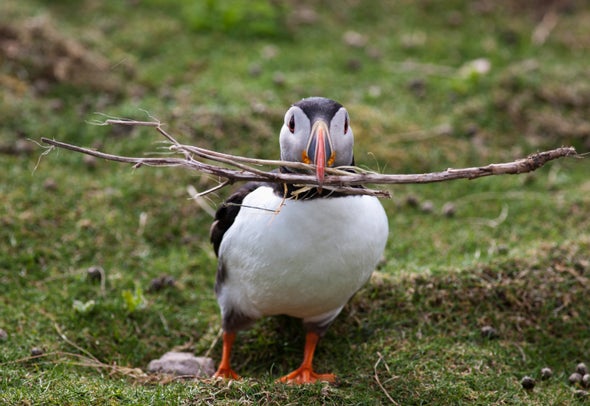(单词翻译:单击)
听力文本
This is Scientific American's 60-second Science, I'm Christopher Intagliata.
We humans used to think that our ability to use tools made us different from all other animals. But then we found out that chimps use tools, too, such as twigs to gather termite snacks and rocks to hammer open nuts. And some birds use tools—like brainy New Caledonian crows, which can assemble multipart tools to solve puzzle boxes presented to them by researchers.
Now we've learned that a different group of birds—seabirds—can also use tools. Scientists spied on Atlantic puffins, the distinctive tuxedoed birds with bright orange beaks. And in 2014 the observers spotted one floating on the sea off Wales, scratching its back with a stick.
Then, in 2018, the researchers caught another tool-using puffin on camera, on Iceland's Grímsey Island.
(CLIP: Video)

In a short video clip, a puffin can be seen grabbing a stick with its beak and then using it to scratch its chest—perhaps to dislodge one of the seabird ticks infesting the island that summer.
The details about puffin proficiency are in the Proceedings of the National Academy of Sciences.
Study author Annette Fayet told Scientific American in an e-mail that these two instances don't prove that seabirds are highly intelligent—though they could be smarter than we thought. But what is certain, she says, is that puffin populations are crashing, and it's largely the fault of us and our tools—which have led to overfishing, climate change, marine pollution and the presence of invasive species, all of which make seabird life harder. It would be nice to keep puffins and their compatriots around and find out just what else we don't know that they're capable of.
Thanks for listening for Scientific American's 60-second Science. I'm Christopher Intagliata.
参考译文
这里是科学美国人——60秒科学系列,我是克里斯托弗·因塔格里塔。
我们人类过去认为,使用工具的能力使我们区别于其他动物。但后来我们发现黑猩猩也能使用工具,比如用树枝收集白蚁小吃和用石头砸开坚果。有些鸟类也会使用工具,比如聪明的新喀里多尼亚乌鸦,它们能集合多种工具来解决研究人员给它们的难题箱。
现在我们知道,另一种鸟类——海鸟——也可以使用工具。科学家观察了北极海鹦,这是一种独特鸟类,其喙呈明亮的橙色,仿佛穿着燕尾服。2014年,观察人员发现,一只漂浮在威尔士海域的北极海鹦,在用棍子挠背。
之后,2018年,研究人员在冰岛格里姆西岛拍摄到另一种使用工具的海鹦。
(视频剪辑录音)
在一个视频片段中,我们可以看到一只海鹦用嘴叼着棍子,然后用它刮擦胸部,这可能是为了弄出那年夏天在该岛泛滥的一种海鸟蜱虫。
海鹦能力的详细信息刊登在《美国国家科学院学报》上。
该研究作者安妮特·法伊在电子邮件中告诉《科学美国人》,这两个例子并不能证明海鸟拥有高度智慧,尽管它们可能比我们想象的要聪明。但她表示,有一点可以肯定,那就是海鹦种群正在瓦解,这很大程度上要归咎于我们和我们的工具,由此导致了过度捕捞、气候变化、海洋污染和入侵物种,所有这些都使海鸟的生活更加艰难。让海鹦及其同胞留在这里,发现它们还有什么我们尚未知晓的能力,会是件很美好的事情。
谢谢大家收听科学美国人——60秒科学。我是克里斯托弗·因塔利亚塔。
译文为可可英语翻译,未经授权请勿转载!
重点讲解
重点讲解:
1. used to do sth. 过去常常;过去曾;
People used to come and visit him every day.
人们过去每天都来拜访他。
2. spy on 秘密监视;
That day he spied on her while pretending to work on the shrubs.
那天,他假装在修剪灌木,秘密对她进行监视。
3. lead to 招致;致使;导致;
Abuse can lead to both psychological and emotional problems.
虐待可造成心理和情绪上的问题。
4. be capable of 有…能力的;能够…的;
Every student in the class is capable of passing the exam.
班上每个同学都有能力通过这次考试。


